How to Spot Health Issues Early Before They Become Expensive Vet Visits
Health Issues Early Before They Become Expensive Vet Visits Notice Sudden Changes in BehaviorCatching health issues early often starts with behavior. If your pet is acting differently — sleeping more, avoiding food, or hiding — it’s time to pay attention. Keep a journal of your pet’s daily habits so changes are easier to detect.
2. Check Eyes, Ears, and Nose Regularly
Look at your pet’s eyes — they should be clear and alert. Discharge or squinting can signal infection. Ears should be clean with no strong odor. If your pet scratches its ears or shakes its head often, that’s a sign of trouble. A dry or crusty nose also points to health concerns.
3. Inspect Skin and Coat Condition
Run your hands through your pet’s fur weekly. Look for bumps, scabs, bald patches, or excessive scratching. A dull coat may mean poor diet, stress, or parasites. Don’t ignore redness or rashes, especially around the neck and tail.
4. Monitor Eating and Drinking Habits
Has your pet started eating less or drinking too much water? That could mean illness. Changes in appetite or thirst may be signs of kidney or liver problems. Always measure meals and use the same bowl to track changes.
5. Observe Bathroom Patterns
Healthy pets urinate and poop on a regular schedule. Watch for diarrhea, constipation, or blood in stool or urine. These are often the earliest symptoms of serious internal issues.
6. Watch for Changes in Movement or Gait
Is your pet limping or walking slower than usual? Stiffness or reduced activity could point to joint pain, arthritis, or muscle issues. Catching this early can save you from expensive treatments later.
7. Pay Attention to Bad Breath
Bad breath is not normal. It may indicate dental problems or internal infections. Check the gums — they should be pink and firm. Redness, swelling, or loose teeth are warning signs that require immediate attention.
8. Inspect Paws and Nails
Check your pet’s paws for cuts, swelling, or infections. Long nails can cause pain and walking issues. Clean between their toes and keep nails trimmed to avoid paw injuries.
9. Listen to Breathing Patterns
Heavy breathing without activity, wheezing, or coughing are not healthy. Open-mouth breathing while resting is a red flag and may suggest heart or lung issues.
10. Feel for Lumps and Bumps
Lumps can be harmless — or dangerous. Gently feel under your pet’s fur every week. If you notice a new bump or one that’s growing fast, contact your vet right away.
11. Weigh Your Pet Regularly
Sudden weight gain or loss could mean metabolic or digestive issues. Weigh your pet weekly and track the results. Even small changes can be a big deal if left unchecked.
12. Don’t Skip Yearly Vet Exams
Yearly vet visits are essential. Vets can spot what we can’t. They’ll do bloodwork, check dental health, and catch problems early before they become expensive emergencies.
13. Stay Consistent with Preventive Treatments
Flea, tick, and worm prevention is not optional. Missing a dose can lead to costly infections. Use reminders to keep your pet protected all year.
14. Trust Your Gut Feeling
You know your pet best. If something seems off, it probably is. Don’t wait until the problem gets worse. Early action saves lives and money.
Your pet’s health depends on you noticing the little things.
By staying alert and doing simple weekly checks, you can catch health issues early — before they turn into expensive vet visits. Regular observation, good habits, and timely action go a long way toward keeping your pet happy, healthy, and safe.
If you want to read more information about how to boost traffic on your Website just visit –> The Insider’s Views


